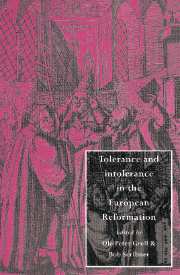Book contents
- Frontmatter
- Contents
- List of contributors
- Preface
- Dedication
- 1 Introduction
- 2 The travail of tolerance: containing chaos in early modern Europe
- 3 Preconditions of tolerance and intolerance in sixteenth-century Germany
- 4 Heresy executions in Reformation Europe, 1520–1565
- 5 Un roi, une loi, deux fois: parameters for the history of Catholic-Reformed co-existence in France, 1555–1685
- 6 Confession, conscience and honour: the limits of magisterial tolerance in sixteenth-century Strassburg
- 7 One Reformation or many? Protestant identities in the later Reformation in Germany
- 8 Toleration in the early Swiss Reformation: the art and politics of Niklaus Manuel of Berne
- 9 Tolerance and intolerance in sixteenth-century Basle
- 10 Exile and tolerance
- 11 The politics of toleration in the Free Netherlands, 1572–1620
- 12 Archbishop Cranmer: concord and tolerance in a changing Church
- 13 Toleration for Catholics in the Puritan revolution
- 14 The question of tolerance in Bohemia and Moravia in the age of the Reformation
- 15 Tolerance and intolerance in sixteenth-century Hungary
- 16 Protestant confessionalisation in the towns of Royal Prussia and the practice of religious toleration in Poland-Lithuania
- Index
7 - One Reformation or many? Protestant identities in the later Reformation in Germany
Published online by Cambridge University Press: 07 December 2009
- Frontmatter
- Contents
- List of contributors
- Preface
- Dedication
- 1 Introduction
- 2 The travail of tolerance: containing chaos in early modern Europe
- 3 Preconditions of tolerance and intolerance in sixteenth-century Germany
- 4 Heresy executions in Reformation Europe, 1520–1565
- 5 Un roi, une loi, deux fois: parameters for the history of Catholic-Reformed co-existence in France, 1555–1685
- 6 Confession, conscience and honour: the limits of magisterial tolerance in sixteenth-century Strassburg
- 7 One Reformation or many? Protestant identities in the later Reformation in Germany
- 8 Toleration in the early Swiss Reformation: the art and politics of Niklaus Manuel of Berne
- 9 Tolerance and intolerance in sixteenth-century Basle
- 10 Exile and tolerance
- 11 The politics of toleration in the Free Netherlands, 1572–1620
- 12 Archbishop Cranmer: concord and tolerance in a changing Church
- 13 Toleration for Catholics in the Puritan revolution
- 14 The question of tolerance in Bohemia and Moravia in the age of the Reformation
- 15 Tolerance and intolerance in sixteenth-century Hungary
- 16 Protestant confessionalisation in the towns of Royal Prussia and the practice of religious toleration in Poland-Lithuania
- Index
Summary
The later German Reformation between the Peace of Augsburg and the Thirty Years' War offers some of the least promising ground in which to explore the history of tolerance. In this period the non-Catholic established churches of Germany fragmented amid mutual acrimony, for reasons as much political as theological. Following his defeat of the Schmalkaldic League in 1547, Charles V transferred the electoral dignity of Saxony to his Lutheran ally Duke Moritz. With it came the city and university of Wittenberg. The theologians of anti-imperial Jena and Magdeburg soon accused Philip Melanchthon's faculty of temporizing with the Emperor over the Interim, and of diluting the heritage of Martin Luther's Reformation. The ensuing controversies took much of their bitterness from the theologians who felt deprived of the one leader whose stature had held them together, then betrayed by their colleagues in the face of military defeat. Until Counter-Reformation Catholicism began to threaten the Lutheran churches from its Bavarian base, Protestants could afford the luxury of always stressing what divided them from other Protestants rather from Catholics. While Lutheranism remained divided, no one could agree on how to interpret the clause of the Peace of Augsburg which gave only ‘those who subscribed to the Augsburg Confession’ legal rights. The Reformed tradition, the ‘second Reformation’ or, if one prefers, German Calvinism, exploited that ambiguity to grow and spread, while rival theologians fulminated ineffectually against each other. The Formula of Concord, which partly re-united the Lutheran churches in 1577, accentuated the strife between Lutheran and by now well-established Reformed churches in Germany.
- Type
- Chapter
- Information
- Tolerance and Intolerance in the European Reformation , pp. 108 - 127Publisher: Cambridge University PressPrint publication year: 1996
- 5
- Cited by



